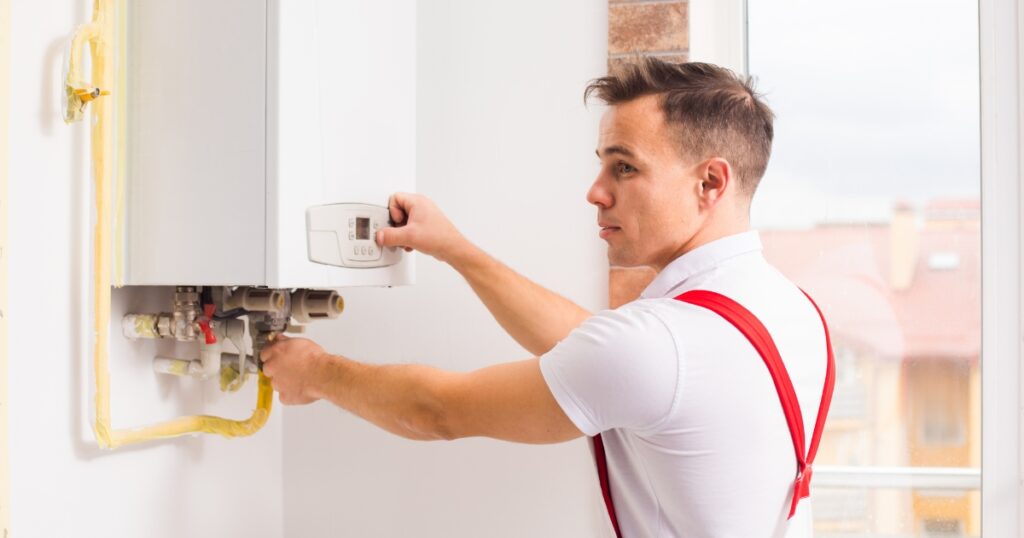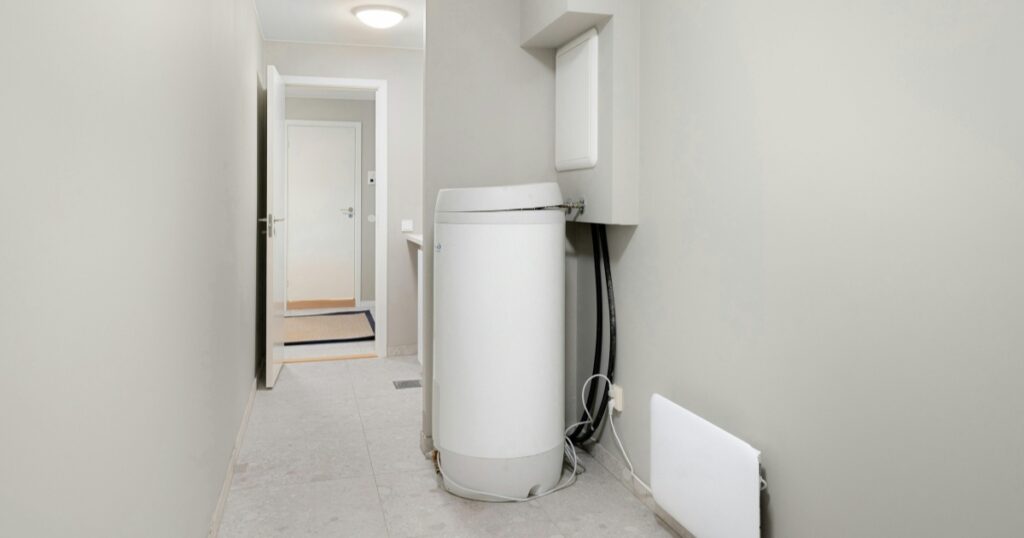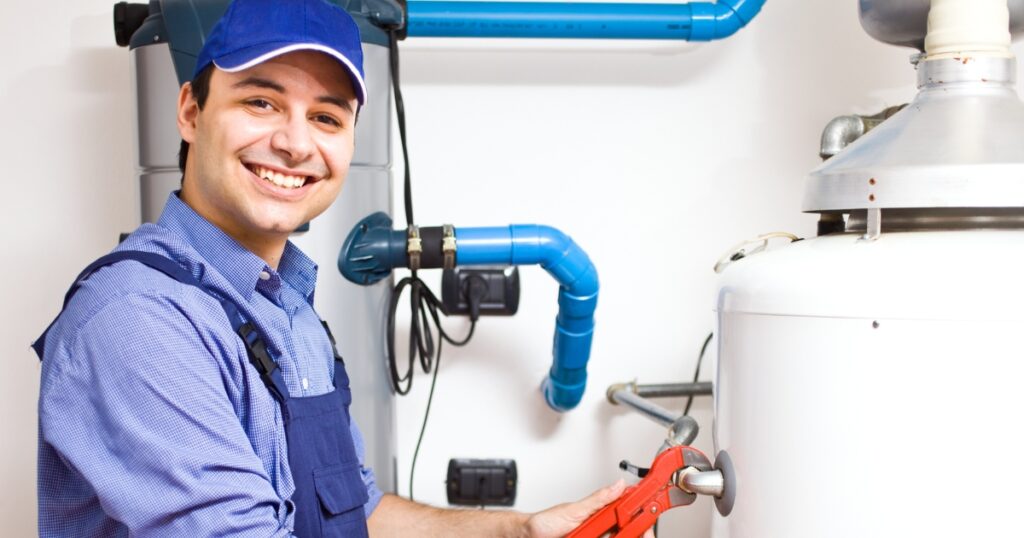Struggling with low hot water pressure can turn the simple act of washing up into a right pain. We’ve all been around the block and know just how maddening it is, considering the average Aussie household goes through about 50 litres of hot water per head every single day.
But no worries! We’ve dug around for answers and uncovered a few swift fixes to pump up your system’s grunt. Keep your eyes peeled for some handy tips coming your way!
Key Takeaways
- Clearing blockages and regularly flushing out your hot water system can prevent sediment buildup, ensuring better water flow and pressure.
- If you’ve got low hot water pressure, inspecting shut-off valves, and checking for incorrectly sized water lines, or faulty pressure regulators might reveal the problem. Open any partially closed valves and consider upgrades or replacements as needed.
- Changing worn-out tap fixtures and plumbing parts can also improve hot water pressure. Look for signs of damage or leaks in your pipes, taps, and showerheads.
- Keeping filters clean is crucial for maintaining good hot water pressure. Regularly remove debris from aerators and showerhead filters to keep the water flowing smoothly.
- Adjusting the tempering valve helps regulate your home’s hot water temperature and can impact overall hot water pressure. An appropriate adjustment might resolve issues with inconsistent temperatures or pressures.

What Causes Low Hot Water Pressure?
Sediment and scale buildup in the hot water system can cause low hot water pressure, along with issues such as multiple bends in plumbing lines, partially closed shut-off valves, general low water pressure, incorrectly sized water lines, a faulty pressure regulator, or worn out plumbing fixtures.
Accumulation of sediment and scale in hot water system
We often find that a major reason for low hot water pressure is the buildup of sediment and scale in the system. This problem usually originates from hard water, which carries minerals that gradually deposit inside pipes and on heating elements.
These deposits restrict water flow, forcing your system to work harder.
To tackle this issue, we regularly flush our hot water systems to remove any accumulated debris. It’s a simple yet effective way to maintain optimal performance and prevent potential blockages.
Ignoring such maintenance can lead to more severe plumbing problems down the track, so we always keep an eye out for signs of sediment buildup.
Plumbing lines with multiple bends
Dealing with plumbing lines that have multiple bends can lead to low hot water pressure in your home. When the water has to navigate through numerous twists and turns, it can encounter more resistance, resulting in reduced pressure at your taps.
This issue might require a professional plumber’s expertise to assess and rectify, as navigating complex plumbing systems requires specific skills and tools.
Partially closed shut-off valve
If you’re experiencing low hot water pressure, check to see if the shut-off valve is partially closed. This could be limiting the flow of hot water to your fixtures. Turn the valve all the way open to ensure proper water pressure throughout your home.
By doing this, you may resolve your low hot water pressure issue quickly and easily.
General low water pressure
When experiencing low water pressure throughout the house, can be frustrating. We’ve encountered this issue by checking for simple causes and discovered that problems like sediment build-up, partially closed shut-off valves, or incorrectly sized water lines can lead to a drop in water pressure.
We found that addressing these issues promptly can restore your home’s high-pressure flow. By fixing any blockages, adjusting the tempering valve if necessary, and ensuring plumbing fixtures are in good condition; we observed a significant improvement in water pressure levels.
Moving on to Immediate Solutions to Low Hot Water Pressure will equip you with practical fixes for these common issues.
Incorrectly sized water lines
If you’re experiencing low hot water pressure, incorrectly sized water lines could be the culprit. When the pipes carrying hot water are too small, it restricts the flow and decreases pressure.
This can happen when older homes have upgrades made without matching pipe sizes to meet current demands. Upgrading these lines with appropriately sized pipes can significantly improve your hot water pressure.
In some cases, a professional plumber might need to evaluate and replace the incorrectly sized water lines to ensure optimal performance. If you suspect this is an issue in your home, it’s essential to consult a qualified plumber who can assess the situation and recommend appropriate solutions based on your specific plumbing setup and needs.
Faulty pressure regulator
After looking into incorrectly sized water lines, we may find that a faulty pressure regulator is another possible culprit for your low hot water pressure. A malfunctioning pressure regulator can either lead to insufficient or excessive hot water flow, causing discomfort and frustration in your daily activities.
In this case, professional plumbing intervention might be necessary to inspect and potentially replace the faulty pressure regulator with an appropriate-sized one to ensure consistent and adequate hot water pressure throughout your home.
If you’re experiencing persistently low hot water pressure despite attempting various fixes, it’s advisable to seek professional assistance right away.
Worn-out plumbing fixtures
If you’ve already checked and fixed the faulty pressure regulator but are still experiencing low hot water pressure, worn-out plumbing fixtures might be the culprit. Worn-out or deteriorated pipes and fittings can lead to leaks, blockages, or restricted water flow.
Inspect your plumbing fixtures such as faucets, showerheads, and pipe connections for signs of wear and tear. If you notice any corrosion, rust, or visible damage, it’s advisable to consider replacing these components.
Upgrading to newer fixtures can help restore proper water pressure and prevent further issues down the line.
Immediate Solutions to Low Hot Water Pressure
Clear blockages for improved water flow. For detailed steps and tips, delve further into the article.
Checking and clearing blockages
When addressing low hot water pressure issues, we should start by checking and clearing blockages. Here are the steps to follow:
- Inspect and clean the aerator on your taps to remove debris or sediment accumulation.
- Check for any clogs in the showerhead by removing it and cleaning it thoroughly.
- Examine the hot water system’s inlet valve for any blockages and clear them accordingly.
- Clear out any build-up in the piping system by flushing it with clean water.
By following these steps, we can effectively address blockages that may be causing low hot water pressure in our homes.
Replacing or repairing tap fixtures
If you are experiencing low hot water pressure, replacing or repairing tap fixtures can help alleviate the issue. Here are some quick steps:
- Turn off the water supply to the affected area.
- Use a wrench to carefully remove and replace any damaged or worn-out fixtures.
- Inspect for any leaks or loose connections and tighten as necessary.
- Test the water pressure to ensure the fix has been successful.
By addressing tap fixtures, you may see an improvement in your hot water pressure without having to call in a professional plumber right away.
Addressing any water leaks
When addressing water leaks, we should first inspect all visible plumbing fixtures for any signs of dripping or pooling water. We should also check for water stains on walls and ceilings as they may indicate hidden leaks.
Next, we need to identify the source of the leak and promptly repair or replace any damaged pipes, fittings, or seals. Regularly monitoring our water meter for unusual fluctuations can also help detect hidden leaks early. It is important to seek professional assistance if we are unable to locate or fix the source of the leak ourselves.
Checking and cleaning filters
If you’re experiencing low hot water pressure, checking and cleaning filters is essential. Here’s what you need to do:
- Firstly, turn off the water supply to the affected area.
- Remove the filter from the faucet or showerhead.
- Inspect the filter for any debris or sediment buildup.
- Clean the filter under running water or by soaking it in vinegar if necessary.
- Reinstall the clean filter back into the fixture.
Regular maintenance of filters can significantly improve water pressure and ensure a consistent flow of hot water throughout your home.
Adjusting the tempering valve
If you’re experiencing low hot water pressure, adjusting the tempering valve can help. Here’s what you need to do:
- Locate the tempering valve on your hot water system.
- Use a screwdriver to adjust the temperature setting on the valve.
- Turn the screw clockwise to increase the temperature and counterclockwise to decrease it.
- Test the hot water pressure at various taps in your home to see if the adjustment has made a difference.
This simple adjustment can often improve your hot water pressure, ensuring you get consistent flow throughout your home.
Re-piping or fixing plumbing issues
When it comes to maintaining water pressure, re-piping or fixing plumbing issues is crucial. Here’s what you need to consider:
- Assess the condition of your current pipes and look for any signs of corrosion or damage that may be affecting water flow.
- Consider replacing old, deteriorating pipes with newer, more efficient materials to improve water pressure and prevent future issues.
- Address any leaks in your plumbing system promptly, as they can significantly impact water pressure.
- Ensure that all plumbing fixtures are properly connected and sealed to prevent any leaks that could lead to low hot water pressure.
- Seek professional assistance from a licensed plumber to accurately diagnose and address any complex plumbing issues impacting your hot water pressure.
- Consider upgrading your plumbing system to accommodate increased demand or changing water pressure requirements within your home.
Properly addressing and resolving plumbing issues can lead to improved hot water pressure throughout your home.
Installing an appropriate-sized pressure regulator
When addressing low hot water pressure, installing an appropriate-sized pressure regulator is crucial. This ensures that the water pressure is regulated and optimised for your specific needs. When selecting a pressure regulator, consider factors such as the size of your home, the number of fixtures, and the existing water pressure.
- Consult with a professional to determine the appropriate size for your home’s specific requirements.
- Ensure that the pressure regulator is installed correctly and calibrated to maintain consistent hot water pressure.
- Regularly check and adjust the pressure setting based on any changes in your plumbing system or usage patterns.
- Periodically inspect and replace the pressure regulator if it shows signs of wear or malfunction to maintain optimal water pressure.
Installing an appropriately sized pressure regulator can significantly improve hot water pressure and prevent potential issues associated with low or fluctuating water pressure.
Common Water Pressure-Related Problems
Low hot water pressure in winter can be a frustrating issue for many homeowners. In Bayside Melbourne, high water pressure is a common concern that needs attention.
Low hot water pressure in winter
In winter, we often experience low hot water pressure due to cold temperatures causing the water to lose velocity as it travels through pipes. This can lead to reduced flow and pressure in your hot water system.

Additionally, factors such as sediment build-up or blockages within the plumbing lines can exacerbate the issue, resulting in low hot water pressure when you need it most.
To tackle low hot water pressure during winter, address any potential blockages promptly by clearing filters or seeking professional assistance if needed. It’s also a good idea to insulate exposed pipes and consider adjusting the temperature setting on your hot water system for optimised performance during colder months.
High water pressure in Bayside Melbourne
Dealing with high water pressure in Bayside Melbourne can lead to various plumbing issues and potential damage. Excessive pressure can stress your pipes, causing leaks and even bursts.
It’s crucial to address this issue promptly to prevent any costly repair work down the line. Installing a pressure regulator or having an expert adjust the existing one can help stabilise the water pressure, safeguarding your entire plumbing system from unnecessary strain.
If left unattended, high water pressure could result in premature wear and tear on your fixtures and appliances, leading to more frequent repairs or replacements. Monitoring and regulating the water pressure in your home is essential for maintaining a healthy plumbing system.
Signs You Need Professional Help
– Constant low hot water pressure despite attempts to fix it
– Fluctuating water pressure and unusual plumbing noises
Constant low hot water pressure despite trying to fix it
If you’re experiencing constant low hot water pressure, it might be time to call in a professional plumber. It’s important not to ignore this issue as it can lead to further damage and inconvenience.
Our team has encountered similar problems before, and we understand the frustration it brings. Let’s work together to find a solution that suits your needs.
We’ve been through several troubleshooting steps ourselves, so rest assured that we have the expertise to get your hot water pressure back on track. Whether it’s adjusting the tempering valve or re-piping plumbing lines, our experience allows us to quickly identify and address the root cause of your low hot water pressure problem.
Water pressure keeps fluctuating
If the water pressure in your home keeps fluctuating, it might be a sign of an underlying issue that needs attention. We need to inspect the plumbing lines for any blockages or leaks and ensure that all valves are fully open.
It’s important to address this issue promptly to avoid any further damage to your hot water system.
Unusual noises from plumbing fixtures
If you notice unusual noises coming from your plumbing fixtures, it may indicate underlying issues that need attention. These noises could be signs of loose components, worn-out parts, or water pressure problems within the plumbing system.
This might include banging or rattling sounds when turning on taps or flushing toilets. Addressing these unusual sounds promptly can help prevent further damage and ensure the smooth functioning of your plumbing fixtures.
Regular maintenance and professional inspections can help identify and resolve any issues causing these unusual noises.
Higher than usual water bills
If you’re facing higher than usual water bills, it could be a sign of an underlying issue with your hot water system. This increase in cost may indicate a leak or inefficiency within the system.
It’s essential to address this promptly to avoid further waste and expense.
When experiencing unexpectedly high water bills, it’s crucial to investigate and resolve the root cause. Ignoring these costs can lead to more significant problems down the line, impacting both your wallet and the environment.
Fix Your Low Hot Water Pressure Issues
When faced with low hot water pressure problems, we have several quick fixes at our disposal. These solutions include checking for blockages in the plumbing lines, repairing or replacing tap fixtures, addressing leaks promptly, and adjusting the tempering valve if needed.
If these immediate remedies do not yield satisfactory results, it may be time to seek professional help to diagnose and fix the underlying issues causing low hot water pressure. Contact us today and solve your low hot water pressure issues.






